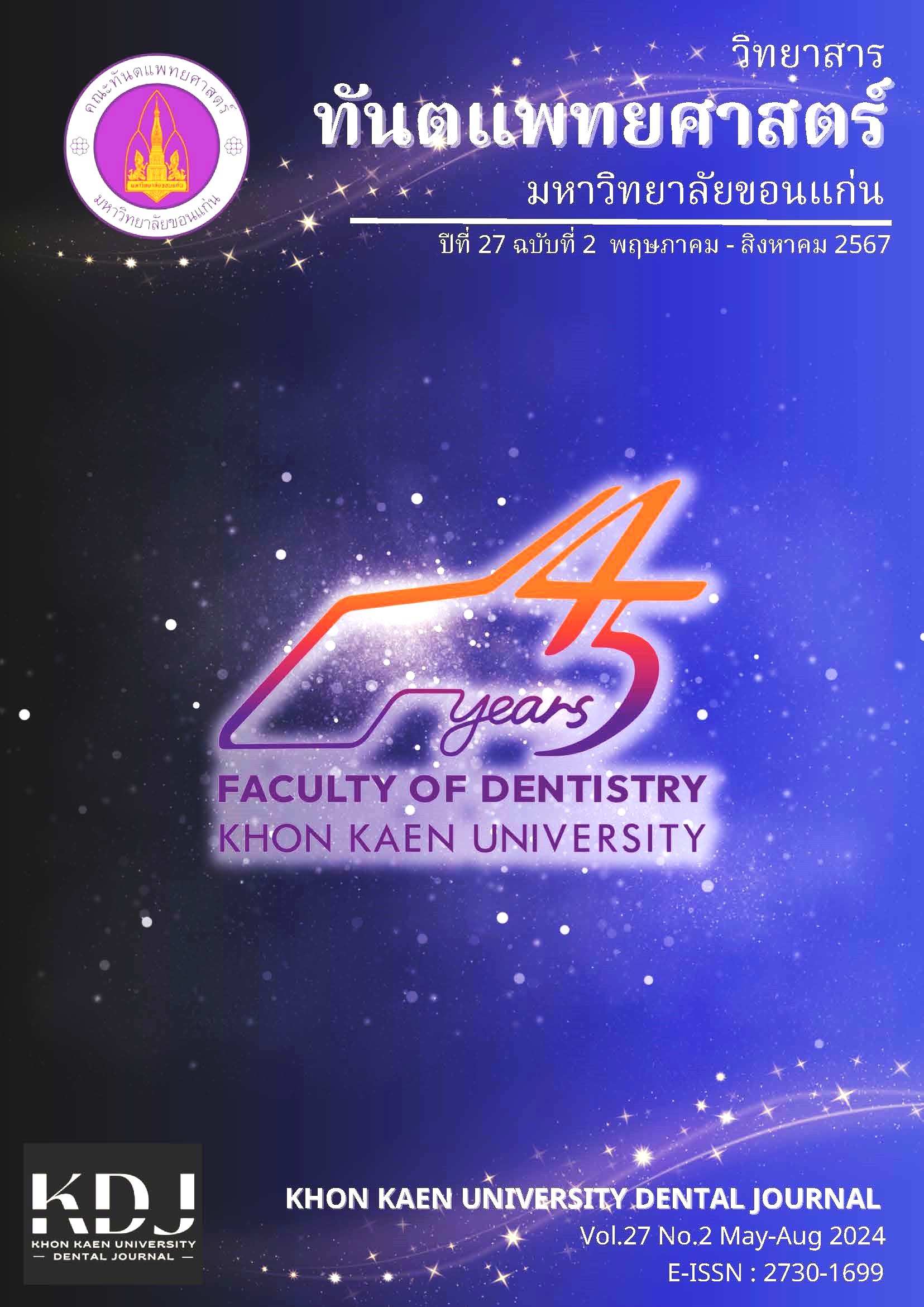วัสดุสำหรับอวัยวะประดิษฐ์ขากรรไกรและใบหน้านอกช่องปาก ตอนที่ 1: ประวัติและซิลิโคน อิลาสโตเมอร์
Main Article Content
บทคัดย่อ
ตั้งแต่อดีตจนถึงปัจจุบันมีการใช้วัสดุประเภทต่าง ๆ เพื่อนำมาประดิษฐ์เป็นอวัยวะเทียมบนใบหน้า แต่เนื่องด้วยข้อจำกัดบางประการจึงทำให้วัสดุบางชนิด เช่น ยางพาราวัลคาไนซ์ และพอลิยูรีเทน ไม่ได้รับรับความนิยม ขณะที่ ซิลิโคนอิลาสโตเมอร์ เป็นวัสดุที่ได้รับความนิยมสูงสุด เนื่องจากมีความอ่อนนุ่ม ยืดหยุ่น ให้ผิวสัมผัส และสามารถตกแต่งสีให้เหมือนผิวหนังได้ ซึ่งวัสดุกลุ่มนี้ยังแบ่งออกเป็นหลายประเภท แต่จะมีเฉพาะบางประเภทเท่านั้นที่ยังคงนำมาใช้งานอยู่ ถึงอย่างไรก็ตามซิลิโคนอิลาสโตเมอร์ ก็ยังไม่ใช่วัสดุที่มีสมบัติตามอุดมคติที่ดีที่สุดสำหรับการผลิตอวัยวะเทียม เพราะมีข้อจำกัดบางประการ ดังนั้นการศึกษาสมบัติของวัสดุกลุ่มนี้จึงเป็นสิ่งจำเป็น เพื่อประโยชน์ในการผลิตอวัยวะเทียมให้กับผู้ป่วย
Article Details

อนุญาตภายใต้เงื่อนไข Creative Commons Attribution-NonCommercial-NoDerivatives 4.0 International License.
บทความ ข้อมูล เนื้อหา รูปภาพ ฯลฯ ทีได้รับการลงตีพิมพ์ในวิทยาสารทันตแพทยศาสตร์ มหาวิทยาลัยขอนแก่นถือเป็นลิขสิทธิ์เฉพาะของคณะทันตแพทยศาสตร์ มหาวิทยาลัยขอนแก่น หากบุคคลหรือหน่วยงานใดต้องการนำทั้งหมดหรือส่วนหนึ่งส่วนใดไปเผยแพร่ต่อหรือเพื่อกระทำการใด ๆ จะต้องได้รับอนุญาตเป็นลายลักษณ์อักษร จากคณะทันตแพทยศาสตร์ มหาวิทยาลัยขอนแก่นก่อนเท่านั้น
เอกสารอ้างอิง
Heller HL, McKinstry RE. Facial Materials. In: McKinstry RE, editor. Fundamentals of Facial Prosthetics. Arlington,VA: ABI Professional Publications; 1995.
Choubisa D. A comprehensive review of extraoral maxillofacial material: Part I. Int J Dent Res Rev 2022;9(2):85-94.
Valauri AJ. Maxillofacial prosthetics. Aesthetic Plast Surg 1982;6(3):159-64.
Upham RH. Artificial noses and ears. Boston Med Sur 1901;145(19):522-3.
Kazanjian VH. Modern accomplishments in dental and facial prosthesis. J Dent Res 1932;12(5): 651-93.
Peyton FA. History of resins in dentistry. Dent Clin North Am 1975;19:211-22.
Lloyd RS, Brund RR. Maxillofacial prosthetic problems in patients with cancer. J Am Dent Assoc 1947;35(3): 162-70.
Szczepanowska PM, Akhmedovara NG. Gutta percha, natural rubber and balata-chemical characterization of polyisoprenes in the context of cultural heritage. Herit Sci 2023;11(125):1-18.
Hurley PE, History of natural rubber. J Macromol Sci A 1981;15(7):1279-87.
Cai GR. Redefining Vulcanization: Charles Goodyear, Patents, and Industrial Control, 1834-1865. Technol Cult 2010;51(2):357-87.
Hendrickson KE, Corfield JJ, Steven Laurence Danver. The encyclopedia of the industrial revolution in world history. Lanham (Md.): Rowman & Littlefield, Cop;2015.
Roberts RM. Serendipity: Accidental discoveries in science. New York John: Wiley & Sons;1989.
Jones KP, Allen PW. Historical development of the world rubber industry. In: Sethuraj MR, Mathew NM, editors. Natural Rubber: Biology, Cultivation and Technology. London: Elsevier; 1992. p.1-25.
Stephens C. A brief history of the development and use of vulcanised rubber in dentistry. Br Dent J 2023;234(8): 607-10.
Choubisa D. A comprehensive review of extraoral maxillofacial material: Part II: early extraoral maxillofacial materials. Int J Dent Res Rev 2022;9(4): 267-75.
Bykowsky MJ. Latex allergy: an emerging crisis in health care. J S C Med Assoc 1996;92(6):267-70.
Turjanmaa K, Alenius H, Mäkinen-Kiljunen S, Reunala T, Palosuo T. Natural rubber latex allergy. Allergy 1996;51(9):593-602.
Sussman GL, Beezhold DH, Kurup VP. Allergens and natural rubber proteins. J Allergy Clin Immunol 2002;110(2 Suppl):S33-9.
Yeang HY, Arif SA, Yusof F, Sunderasan E. Allergenic proteins of natural rubber latex. Methods 2002;27(1):32-45.
Ravve A. Free-Radical Chain-Growth Polymerization. In: Principles of Polymer Chemistry. 3rd ed. New York: Springer;2012. p.69-150.
Ravve A. Step-Growth Polymerization and Step-Growth Polymers. In: Principles of Polymer Chemistry. 3rd ed. New York: Springer;2012. p.403-535.
Young RJ, Lovell PA. Introduction to polymers. Boca Raton: CRC Press; 2011.
Elias HG. Macromolecules: Volume 1: Chemical Structures and Syntheses 1st ed. New York: WILEY‐VCH;2005.
Common Types of Organic Reactions- Substitution and Addition Reactions [Internet]. Unacademy. Available from:https://unacademy.com/content/jee/study-material/ chemistry/common-types-of-organic-reactions-substitution-and-addition-reactions/
de Buyl F. Silicone sealants and structural adhesives. Int J Adhes Adhes 2001;21(5):411-22.
Soloducho J, Zajac D, Spychalska K, Baluta S, Cabaj J. Conducting silicone-based polymers and their application. Molecules 2021:26(7):1-30.
Shit SC, Shah P. A review on silicone rubber. Natl Acad Sci Lett 2013;36(4):355-65.
Rochow EG. The chemistry of silicones. Sci Am 1984;179(4):50-3.
Iwamoto T. A stable bicyclic compound with two double bonds. Science 2000;290(5491):504-6.
Dvornic PR. Thermal properties of polysiloxanes. In: Jones RG, Ando W, Chojnowski J, editors. Silicon-Containing Polymers: The Science and Technology of Their Synthesis and Applications. Dordrecht: Springer; 2000. p.185-213.
Dobkowski Z, Zielecka M. Thermal analysis of the poly(siloxane)-poly(tetrafluoroethylene) coating system. J Therm Anal Calorim 2002;68:147-58.
Sidorov TA. Asymmetry of Si-O-Si bridge bond and atom groups in silicates. Russ J Inorg Chem 2007;52(4):532-42.
Cruz RLJ, Ross MT, Powell SK, Woodruff MA. Advancements in soft-tissue prosthetics part b: the chemistry of imitating life. Front Bioeng Biotechnol 2020;8:147.
Hutchinson JM. Determination of the glass transition temperature: methods correlation and structural heterogeneity. J Therm Anal Calorim 2009;98:579-89.
Rehage G, Borchard W. The thermodynamics of the glassy state. In: Haward RN, editor. The physics of glassy polymers. Barking: Applied Science Publishers;1973.p.54-107.
Ramli MR, Othman MBH, Arifin A, Ahmad Z. Cross-link network of polydimethylsiloxane via addition and condensation (RTV) mechanisms. Part I: Synthesis and thermal properties. Polym Degrad Stab 2011;96(12): 2064-70.
Gonzaga F, Yu G, Brook M. Polysiloxane elastomers via room temperature, metal-free click chemistry. Macromol 2009;42(23):9220-4.
Craig RG, Koran A, Yu R. Elastomers for maxillofacial applications. Biomater 1980;1(2):112-7.
Lai JH, Wang LL, Ko CC, DeLong RL, Hodges JS. New organosilicon maxillofacial prosthetic materials. Dent Mater 2002;18(3):281-6.
Hulterström AK, Berglund A, Ruyter IE. Wettability, water sorption and water solubility of seven silicone elastomers used for maxillofacial prostheses. J Mater Sci Mater Med 2008;19(1),225-31.
Chalian VA, Phillips RW. Materials in maxillofacial prosthetics. J Biomed Mater Res 1974;8(4 Pt 2):349-63.
Lai JH, Hodges JS. Effects of processing parameters on physical properties of the silicone maxillofacial prosthetic materials. Dent Mater 1999;15(6):450-5.
Curtis J, Colas A. Silicone biomaterials: History and chemistry. In: Ratner BD, Hoffman AS, Schoen FJ, Lemons JE, editors. Biomaterials Science: An Introduction to Materials in Medicine 2nd ed. New York: Elsevier;2004.p.80-6.
Montgomery PC, Kiat-Amnuay S. Survey of currently used materials for fabrication of extraoral maxillofacial prostheses in North America, Europe, Asia, and Australia. J Prosthodont 2010; 19(6):482-90.
Delrin [Internet]. dupont.materialdatacenter.com. [cited 2024 Jan 28]. Available from: https://dupont.materialdatacenter.com/products/datasheet/SI/Liveo%E2%84%A2%20MDX4-%204210
Mitra A, Choudhary S, Garg H, Jagadeesh HG. Maxillofacial Prosthetic Materials- An Inclination Towards Silicones. J Clin Diagn Res 2014;8(12):8-13.
Barnhart GW. A new material and technic in the art of somato-prosthesis. J Dent Res 1960;39(4):836-44.
Udagama A, Drane JB. Use of medical grade methyl urethane silane cross-linked silicone for facial prosthesis. J Prosthet Dent 1982;48(1):86-8.


